Twitter’s Big Weekend
Alright, here’s where we’re at: Over the weekend, Twitter account-locked its content, which means if you weren’t logged in, you couldn’t see it. It seems to be back to normal now. Twitter also introduced rate limits. According to CEO Elon Musk, verified accounts can read 6,000 posts a day, unverified accounts 600 posts, and new unverified accounts 300. I am not positive that this is true, based on my own tests, but whatever, who cares.
Twitter’s Business department put out a statement about the rate limits that also sounds like a lie, claiming that there was no warning issued before the limits started because it was some kind of elaborate sting to “detect and eliminate bots and other bad actors that are harming the platform.” I’m sure the abrupt change to the platform had nothing to do with the bills that were due on June 30th that, according to Platformer, Musk had no intention of paying. I’ve also seen theories that by account-locking tweets, which Musk clearly did because he’s pissy about OpenAI scraping Twitter, they inadvertently DDOS’d themselves, which they, then, decided was malicious activity.
Either way, the double whammy of account-locking tweets and rate limiting caused a pretty disastrous pile-on effect for the platform. Twitter’s SEO visibility, which has always been pretty good, reportedly dropped by around 30%. It seems like it’s beginning to recover, but, man, I sure would hate to be someone paying to use a site that you can’t really use anymore. Like this guy, for instance.
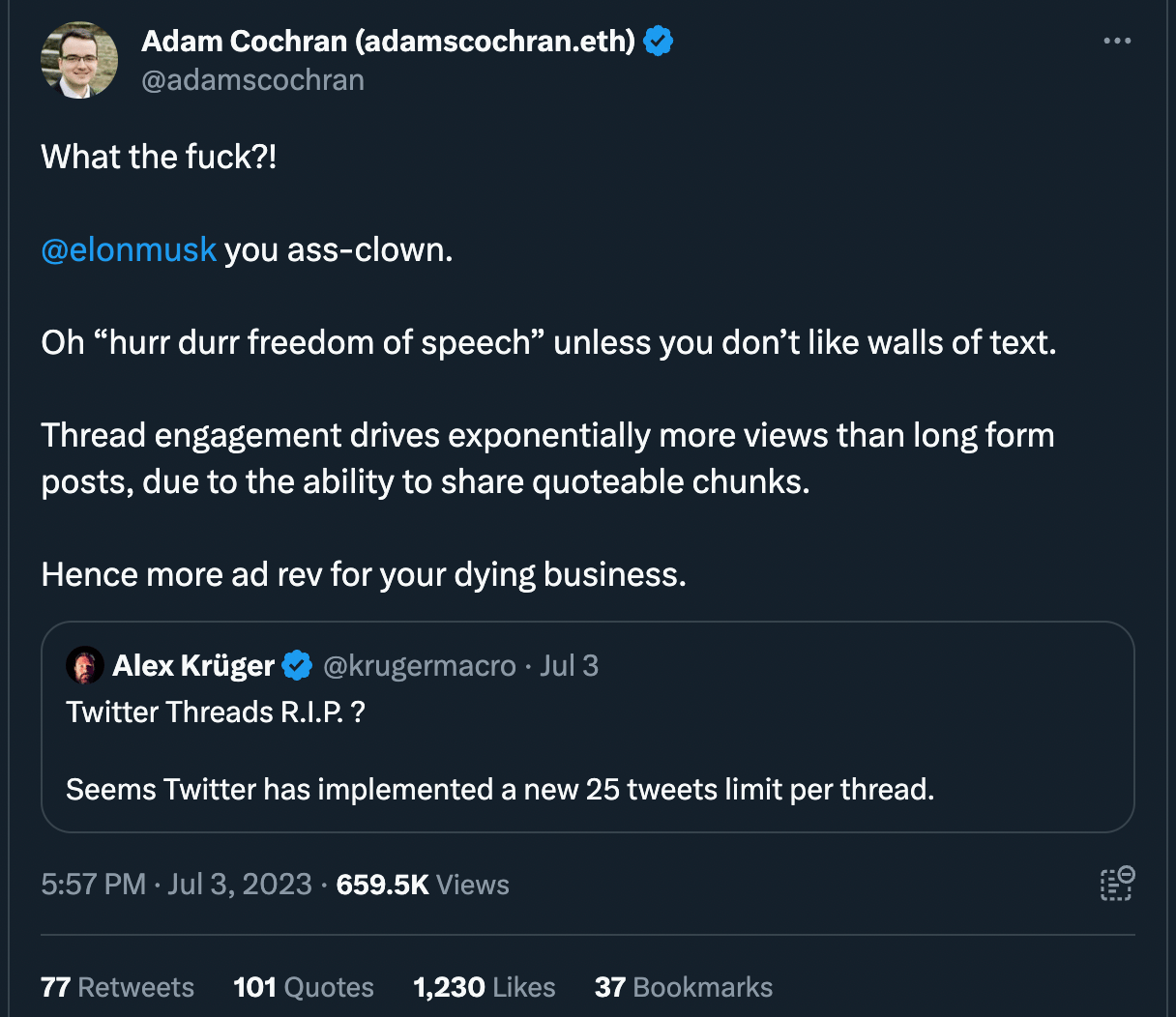
Oh yeah, also, the amount of tweets in a thread were also limited at one point over the weekend. Also, long tweets broke on the iOS app because they don’t load in the app and redirect to the web version of Twitter, but the mobile web version of Twitter couldn’t tell if you’re logged in. And this also made Twitter links on Reddit and other social networks completely worthless.
Then, this week, Musk’s brain trust decided to finally break TweetDeck, which I’ve been using for close to a decade. If you’ve never used TweetDeck before, it offered a few additional features for power users. It allowed multiple live-loading columns, which I used to monitor different countries and communities. It also had a special column called “Activity,” which showed you all the tweets being faved/liked by the accounts you follow. But, most important for brands, it supported teams, allowing multiple users to log in and manage group accounts. This week, the old version of TweetDeck completely broke and Twitter pushed a new version, which will soon be paywalled, not that it works with the rate limits anyways. My TweetDeck has 12 columns running (yeah, I know lol) and it caused a rate limit almost immediately upon opening. But when I’m not limited, the new TweetDeck columns don’t really load anymore. They’ve also done away with the “Activity” column and teams support.
The big winners of the weekend were the Twitter alternatives. Bluesky saw a massive uptick in new users, as did Spill, an app aimed at black internet users. We’re also less than 24 hours from the launch of Threads, Instagram’s Twitter clone.
I’ve seen a bunch of debates about Who Will Win The Twitter Wars. The argument against Threads becoming the new Twitter is what tech analyst Faine Greenwood calls “Terrible Uncle Problem”. Greenwood recently skeeted, “Meta ensuring Threads integrates with Facebook and Instagram means your weird older relatives will easily be able to find you there. A lot of people do NOT want that.” It’s certainly possible, but if it’s really going to come down to Threads or Bluesky, my money is on Threads. Though I doubt either will really capture what Twitter was useful for.
I think hardcore Twitter users have rose-colored glasses about the site’s coolness. The reason for its success, if you can argue that it was ever really successful, wasn’t that it was cooler than Facebook. It was because of its proximity to power. The reason it was so popular with activists, extremists, journalists, and shitposters was because what you posted there could actually affect culture. The thing that ties together pretty much everything that’s happened on Twitter since it launched in 2006 was the possibility that those who were not in power (or wanted more) could influence those who were. And I don’t think it’s an accident that a deranged billionaire broke that, nor do I think it’s accident that we’re suddenly being offered smaller, insular platforms or an offshoot of a Meta app as replacements. The folks in charge clearly don’t want that to happen again.
Do You Subscribe To Garbage Day? Why Not???
It’s $5 a month or $45 a year for the paid weekend edition and Discord access. And it’s $150 a year for all of that, plus the monthly trend reports. The next one drops this week. I also have referrals set up now. You can use this link for that. Hit the green button to find out more about subscribing. Thank you, I love you.
Apes, Liquidated
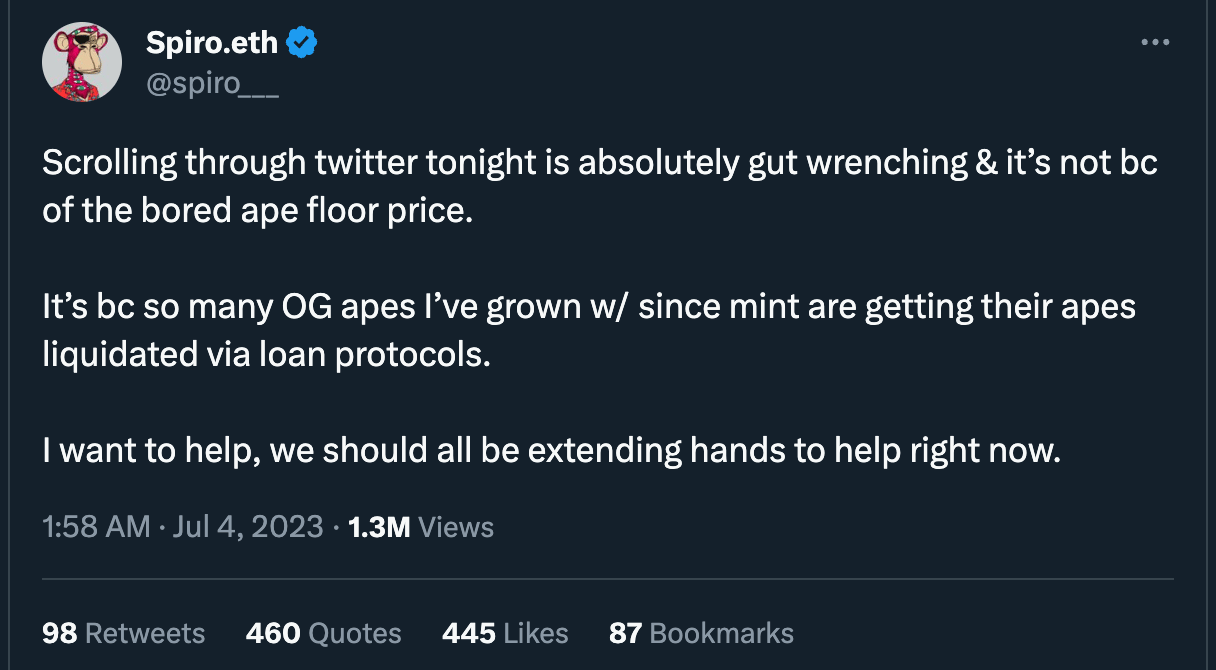
The sound you heard this week was million apes crying out in terror before suddenly being repossessed by crypto loansharks. The market for Bored Ape Yacht Club NFTs has not had a good few months. In April, a user sold 27 apes at once, netting close to $3 million. It also sent the community into free fall. And this week it seems like it finally fell off a cliff.
Please be kind, there are a lot of apes that will go without their slurp juice tonight because their holders took out loans they couldn’t afford to buy JPGs.
Is The AI Craze Actually Over Already?
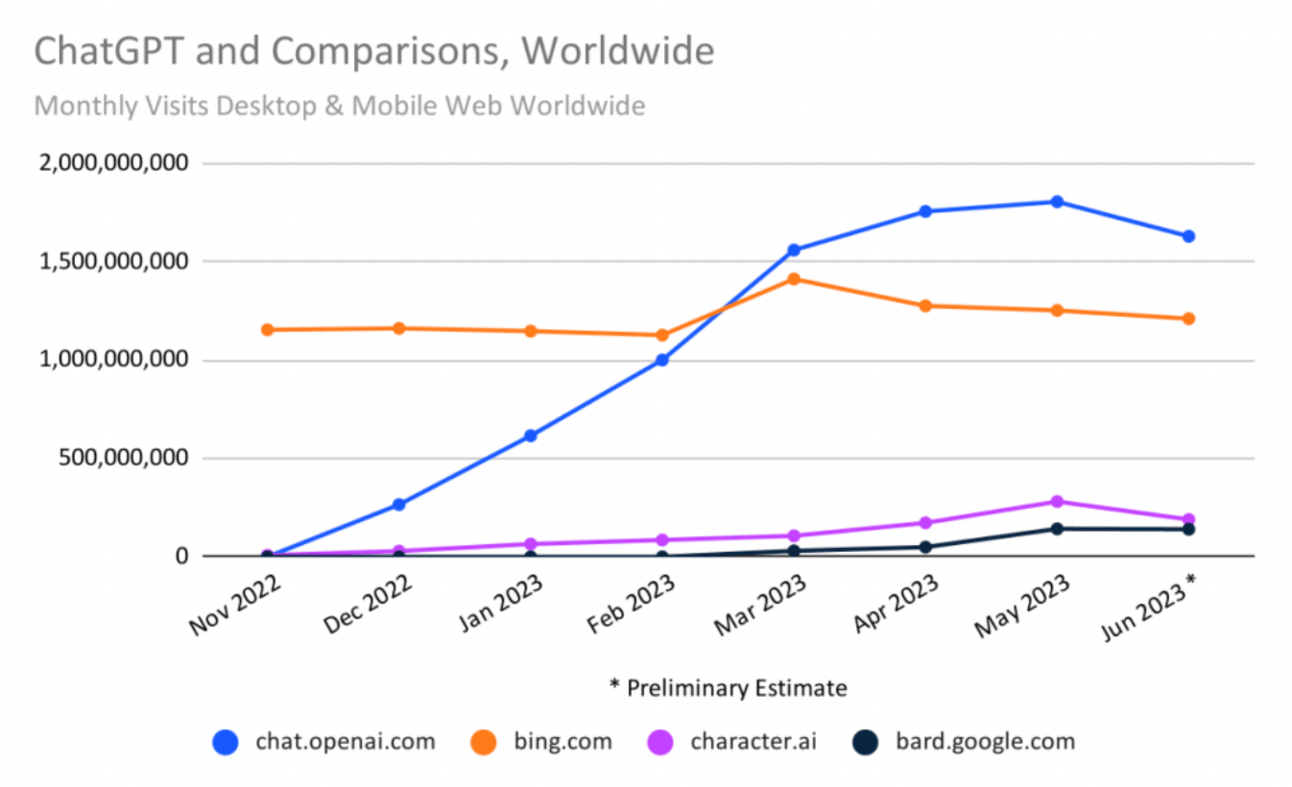
Similarweb published a report this week showing that visits to OpenAI’s ChatGPT in June dropped about 10% from where they were in May. I saw a skeet on Bluesky arguing this might be because students are no longer using it to cheat. And I don’t doubt that generative AI tools are seasonal. Most internet content is. Even Garbage Day traffic dips usually between May and July.
I also think OpenAI may be suffering from their own release schedule. OpenAI dropped GPT-1 in 2018, GPT-2 in 2019, and GPT-3 in 2020. Then GPT-3 exploded in popularity after the launch of ChatGPT last year. OpenAI quickly released GPT-3.5 last December and GPT-4 in March. And I think a lot of AI evangelists got real used to the hype of a new OpenAI widget dropping every couple months.
But to answer the question I poised at the top, no, I don’t think this is evidence that AI was a craze that has ended. ChatGPT is still, as you can see in Similarweb’s chart above, the most popular AI chat interface, but until OpenAI figures out how to build tools that work better on mobile or has a new impressive development to share, things are going to plateau a bit.
Your Camera Roll Is The Last Social Network Left
Yesterday, on Bluesky, journalist and podcaster Michael Hobbes shared a screenshot of a blog post from a user called @hystericempress. If you have Bluesky, you can check out the post here.
Beneath Hobbes’ post, I came across this discussion about where exactly the screenshot came from. I, also, didn’t recognize the platform and was thankful someone pointed me in the right direction.

I chased down the original post. It was written by a furry on Cohost two week ago. I found a link to the post underneath a similar screenshot of it on Mastodon, which is one of the last microblogging platforms that still indexes properly with Google.
@hystericempress also wrote a couple followups about her submarine post. Apparently, it first went viral on Tumblr as a screenshot, then traveled to Twitter, Mastodon, and, finally, where I saw it, on Bluesky.
While trying to track down the actual hyperlink to a post I found a screenshot of on a closed social network I was struck by how on an internet full of closed platforms, broken embeds, and crumbling indexes, the last reliable way to share anything is a screenshot. In other words, the camera roll is, at this point, the real content management system of the social web. This is something that TikTok realized faster than other platforms, with their downloadable watermarked videos that have now become ubiquitous on every platform that allows video.
I subscribe to the belief that internet trends are defined by a ratio of laziness to social reward. Users will always do the laziest possible thing to achieve the maximum amount clout. So, if every platform becomes either a Twitter alternative or a short-form video feed, but all with their own unique requirements for virality, users won’t make individual posts for each. They will instead shotgun blast all of them with the same posts and bet on the odds that something will breakthrough eventually. Which means everything eventually just becomes a reuploaded video or a screenshot from somewhere else.
There Is Something New About Influencers In New York, Though
Bloomberg put out a piece a couple weeks ago about the TikTokers and aspiring-TikTokers raising New York City rent prices. I’ve seen this piece shared a few times lately, most recently by Meta’s Tom Gara, who tweeted, “There’s something so funny about zoomers being like, it’s a TikTok thing, the hottest new viral trend is to live in New York City and spend all your money at bars and restaurants.”
And much of the reactions to this piece have had the same kind of semi-dismissive tone. One of, “well, there’s nothing new about young people wanting to live in New York.” Which is true! Except, it’s not true that content creators, specifically, have wanted to live in New York.
In the late-2000s and early-2010s there were a lot of people in New York working in digital media. More than a few times I heard someone use the term “Silicon Alley” to refer to what I think was a stretch of offices near the Flatiron? And while this new generation of “content creator” was using all the newfangled social media apps to foursquare bars and instagram parties, very few of them were what we would now consider influencers. They worked for traditional companies. And if they ever did become internet famous they were much more likely to either stay in New York and start a podcast or move out to LA to try and break into the entertainment business.
The machinations of influencers were so perplexing to the digital media workers that stayed in their posting stations in New York offices that New York Magazine once asked in a headline, “Why Are All These Influencers Standing in the Middle of the Street?” My theory as to why New Yorkers were so allergic to independent content creators is because for all the tedious guffawing about being a city of hustlers, most of the people who live there crave, on some level, institutional legitimacy and influencers, by definition, don’t get it or really need it. It could also just be that New Yorkers hate tourists and content creators are, in some form, permanent tourists of their own lives.
There were signs that the New York skepticism and/or snobbishness around content creators was changing — there were a couple big breakout independent podcasts, the fascination with Caroline Calloway, the rise of media org-sponsored TikTok hosts — but the real moment I, personally, said, “oh shit, influencers live in New York now,” was when I read this 2021 Vox profile of TikToker Audrey Peters, which made me profoundly uncomfortable for reasons I couldn’t totally explain until I sat down and thought through, well, everything you just read in the paragraphs above.
Anyways, call me an optimist, but I actually think the post-COVID New York TikTok boom is already cresting. I think once these trends become calcified enough to report on, they’re already on their way out. I also don’t think Gen Z TikTokers are driving rents up, but rather documenting its rise due to other factors, like landlords being able to blame TikTok hype to jack up their rents.
Unpacking The Gross CGI Woman Meme
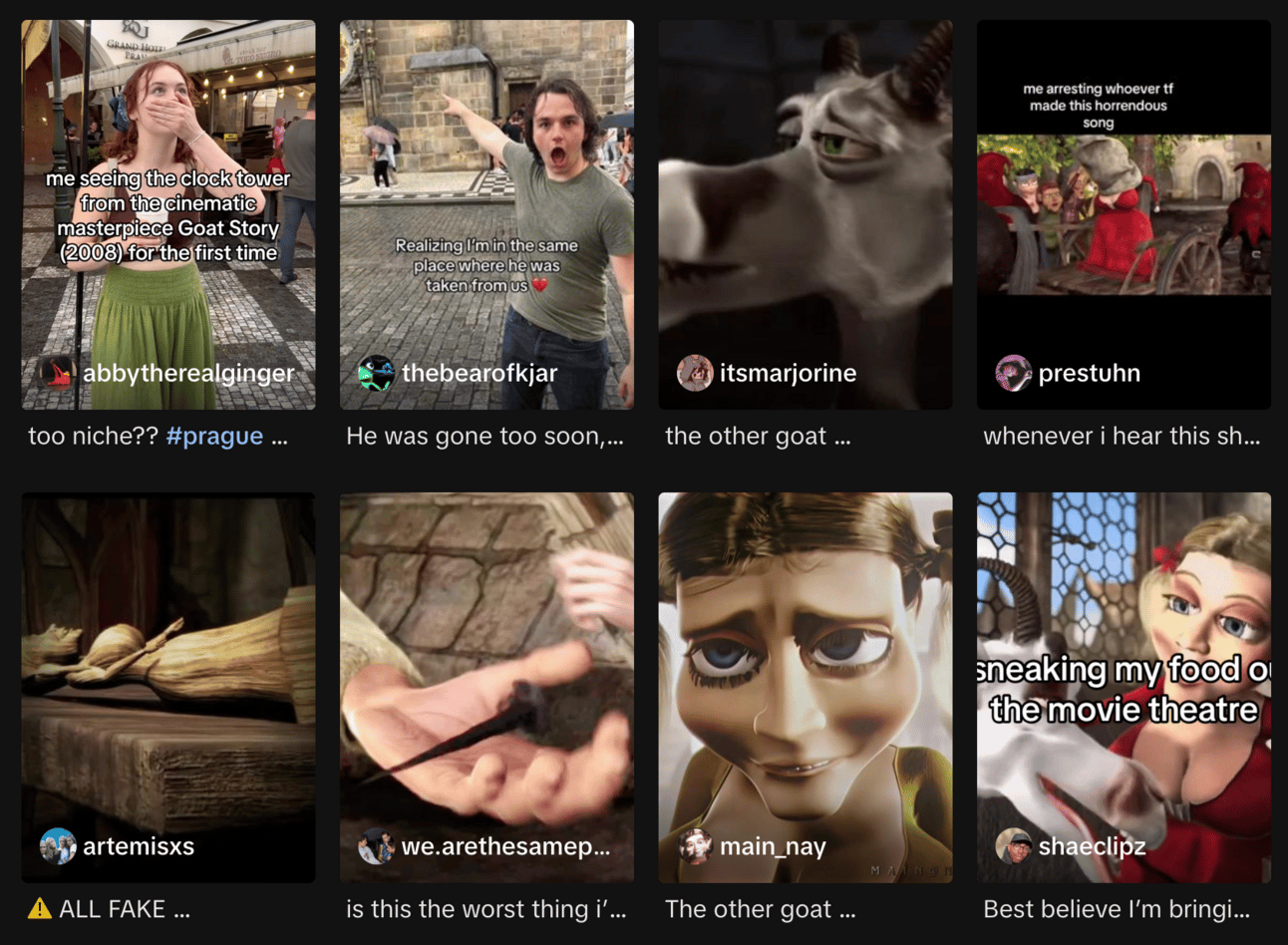
I had seen this gross CGI woman photoshopped into a bunch of different pop stars and couldn’t figure out exactly where it came from. Making matters worse, it’s gone viral on stan Twitter, which is a pretty dense community to begin with. I initially thought this was called “ijbol,” but that’s just an acronym that’s going around right now that stands for “I just burst out laughing.”
The CGI lady is from a 2008 animated film from the Czech Republic called Goat Story. It got a really rough English dub and I guess it was meant to be a really sexual Shrek knockoff or something. Clips from it are now all over Twitter and TikTok.
In case you’re having trouble following a few other memes at the moment: There’s a girl with crimped hair from an old episode of Dance Moms and people are making photoshops about how she’s Taylor Swift.
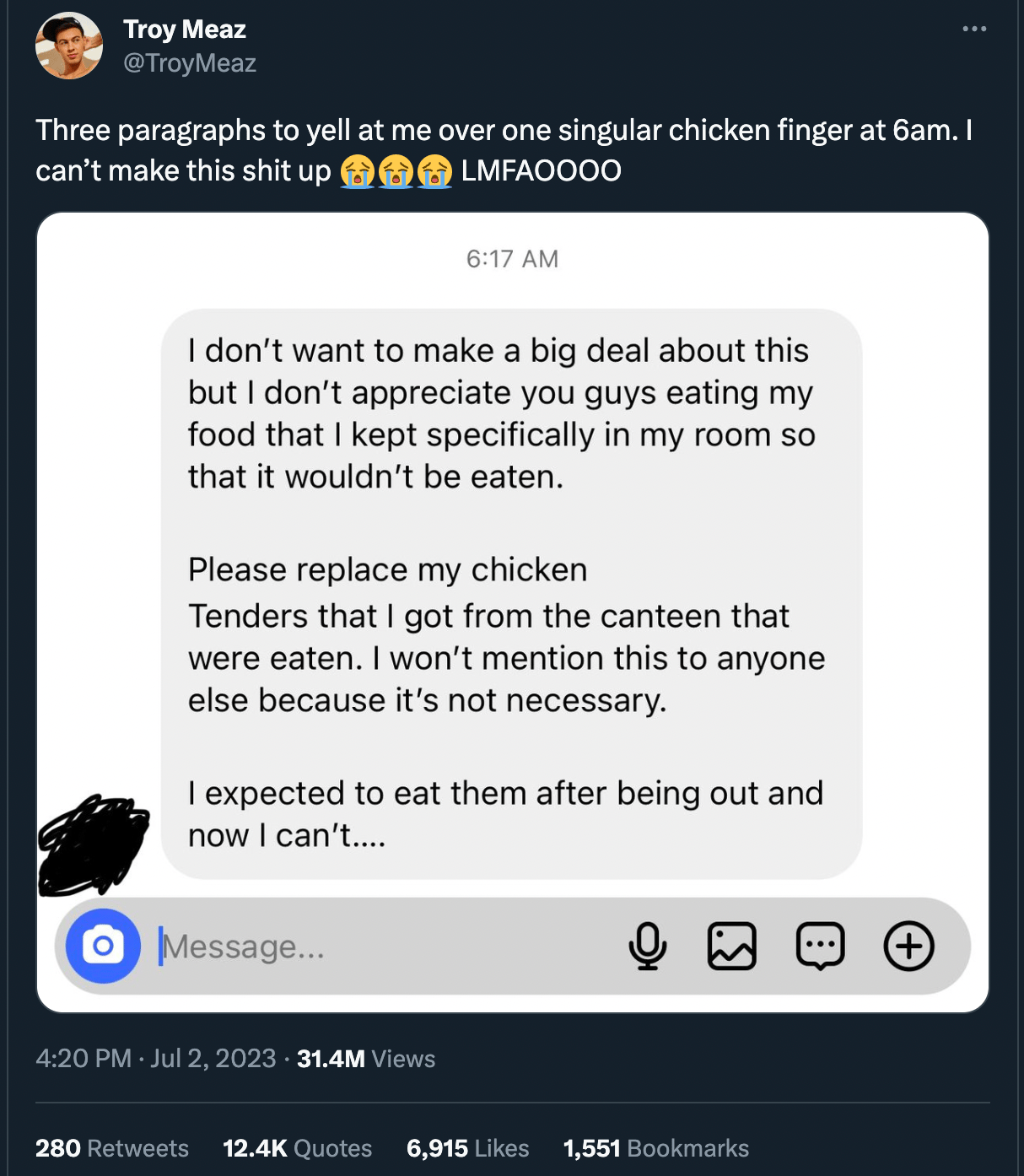
And finally, this guy ate someone’s chicken tenders while staying at house on Fire Island last weekend. The discourse about the chicken nuggets breaks down into three debates:
Is it ok to keep chicken tenders in your room unrefrigerated?
Is it ok to go into someone’s room and eat their chicken tenders?
And, just generally, how expensive chicken nuggets are on Fire Island.
Some Stray Links
P.S. here’s a good cake.
***Any typos in this email are on purpose actually***